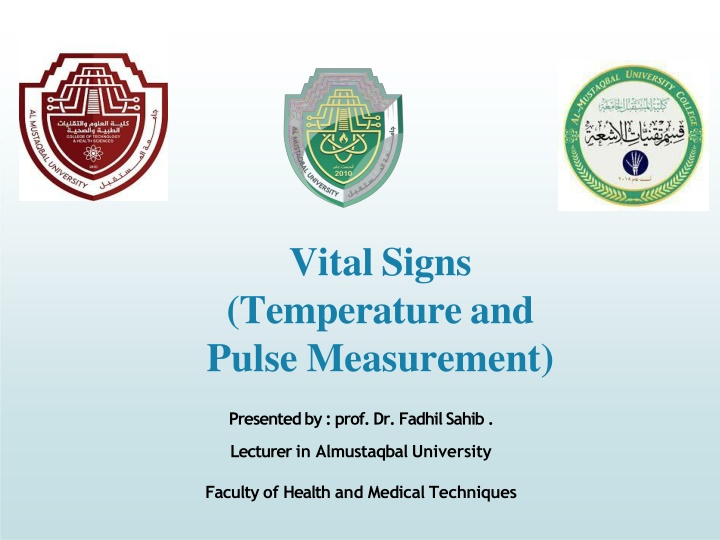
Vital Signs: Temperature, Pulse, and Measurement Methods
Learn about vital signs such as body temperature, pulse, and methods for measurement. Discover the importance of assessing vital signs, the equipment needed, factors affecting body temperature, and common measurement sites. Gain insights into normal ranges and abnormalities like pyrexia and hypothermia.
Download Presentation

Please find below an Image/Link to download the presentation.
The content on the website is provided AS IS for your information and personal use only. It may not be sold, licensed, or shared on other websites without obtaining consent from the author. If you encounter any issues during the download, it is possible that the publisher has removed the file from their server.
You are allowed to download the files provided on this website for personal or commercial use, subject to the condition that they are used lawfully. All files are the property of their respective owners.
The content on the website is provided AS IS for your information and personal use only. It may not be sold, licensed, or shared on other websites without obtaining consent from the author.
E N D
Presentation Transcript
Vital Signs (Temperature and Pulse Measurement) Presented by : prof. Dr. Fadhil Sahib . Lecturer in Almustaqbal University Faculty of Health and Medical Techniques
Vital Signs Definition: Procedure that takes the sign of basic physiology that includes temperature , pulse, respiration and blood pressure. If any abnormality occurs in the body, vital signs change immediately Purpose: 1. To assess the client s condition 2. To determine the baseline values for comparisons 3. To detect changes and abnormalities in the condition of client.
What are the Vital signs? 1.Body temperature 2.Pulse 3. Respiration 4. Blood pressure .
Times to Assess Vital Signs: 1. On admission. 2. When a client has a change in health status such as chest pain or faint. 3. Before and after surgery or an invasive procedure. 4. Before and after the administration of a medication . 5. Before and after any nursing intervention that could affect the vital signs
Equipment 1. Vital sign tray 2. Stethoscope 3. Sphygmomanometer 4. Thermometer 5. Second hand watch 7. Vital sign sheet 8. Cotton swab 9. Disposable gloves if available
1-Body Temperature Body temperature reflects the balance between the heat produced and the heat lost from the body
Factors that affect body temperature are the following: 1.Age. 2. Diurnal variations. 3. Exercise. 4. Hormones. 5. Stress. 6. Environment.
The normal range for Body Temperature in adults between (36 C and 37.5 C) . Pyrexia:- is a body temperature above the normal range (38 C 40.9 ). Hyperpyrexia:- A very high fever, such as 41 C and more. Hypothermia is a body temperature below ( 36 C)
The most common sites for measuring body temperature: 1 -Oral. (2-3) minute. 2. Rectal. (2) minute (-0.5) 3. Axillary. (5-6) minute (+0.5) 4. Skin/temporal artery. 5. Tympanic. Normal temperature 1. Oral ; 37 c 2.Axillary ; 36.5 c 3. Rectal ; 37.6 c
Types of Thermometer 1- Glass mercury thermometer :- (Orally) 2- Electronic thermometer:- ( Axillary )
3 - Tympanic Thermometer 4 - Temporal artery thermometer 5 - A temperature sensitive skin tape
Contraindication for oral temperature 1-Child under age 3 years 2. Old age people 3. Unconscious patient 4. Mental ill patient 5. Oral surgery, lesion or ulcer 6. Nasal obstruction 7. Patient has cough 8. Patient has nasogastric (NG) Tub
Contraindication for rectal temp 1 Rectal surgery 2 Diarrhea 3 Rectal disorder ( bleeding )
Procedure to checking temperature: Wash your hands. 2. Prepare all required equipment s. 3. Introduce your self and explain procedure to client. 4. Provide for client privacy. 5. Place the client in the appropriate position 6. Place the thermometer. 7. Wait the appropriate amount of time. 8. Remove the thermometer . 9. Read the temperature and record it on your worksheet.
2- Pulse The pulse is a wave of blood created by contraction of the left ventricle of the heart. number of times the heart beats in 1 minute. The rate of the pulse is expressed in beats per minute (beats/min)
Factors Affecting the Pulse 1 Age 2 Sex. 3 Exercise 4 Fever 5 Medications. 6 Hypovolemia/dehydration. 7 Stress 8 Position and sleep. 9 Pathology
Pulse Sites : 1. Radial 2. Temporal 3. Carotid 4.Apical ( central ) 5. Brachial 6. Femoral 7. Popliteal 8. Dorsalis Pedi s 9. Posterior tibial
Pulse Assessment 1- Rate Normal ( 60 ---100) beat/ Minute 2- rhythm * Regular Irregular 3- Volume -Strength *Bounding or strong pulse *Normal pulse * weak or threatening pulse *Absent of pulse
Variances in Pulse Rate Tachycardia: pulse rate more than 100 bpm (beat per minuet) Bradycardia: pulse rate less than 60 bpm Dysrhythmia (arrhythmia): irregular rhythm
Procedure to checking pulse rate: 1-Wash your hands. 2. Prepare all required equipment s. 3. Introduce your self and explain procedure to client. 4. Provide for client privacy. 5. Select the pulse point. Normally, the radial pulse is taken. 6.Assist the client to a comfortable resting position. 7.Assess the pulse rhythm and volume for 1 minute. 8. Document the pulse rate, rhythm, and volume and your actions in the client record.





















